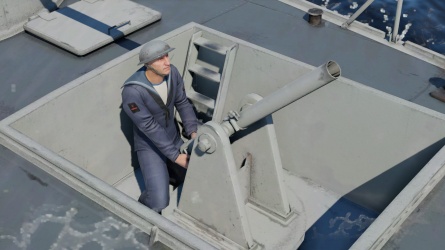Difference between revisions of "Ordnance ML 4.2-inch mortar"
(Added images, Pros and cons, See also and External links.) |
(Added screenshot of the bomb itself) |
||
| Line 17: | Line 17: | ||
=== Effective damage === | === Effective damage === | ||
''Describe the type of damage produced by this type of weapon (high explosive, splash damage, etc)'' | ''Describe the type of damage produced by this type of weapon (high explosive, splash damage, etc)'' | ||
| + | [[File:Ordnance ML 4.2-inch mortar round.jpg|thumb|Mortar bomb launched by the ML 4.2-inch mortar]] | ||
=== Comparison with analogues === | === Comparison with analogues === | ||
Revision as of 18:32, 28 June 2024

Contents
Description
Write an introduction to the article in 2-3 small paragraphs. Briefly tell us about the history of the development and combat using the weaponry and also about its features. Compile a list of air, ground, or naval vehicles that feature this weapon system in the game.
Vehicles equipped with this weapon
General info
The weapon will always fire at a range of 1 km, with a dispersion of ~30 meters forwards/backward and ~60 meters to the sides. This might be caused by the boat rocking on the waves rather than being inherent to the weapon.
The depth charge takes about 15 seconds to reach the target. It makes a small splash when it enters the water, and it detonates about one second later, creating a bigger splash. The damage is low - it requires about 10 hits on target to sink an S-38b in a test sail, and that is a stationary target, so you should not expect the same accuracy in combat. The mortar may have some utility when forcing enemies out of cover behind ships on capture zones, or confusing them with an artillery bombardment.
Effective damage
Describe the type of damage produced by this type of weapon (high explosive, splash damage, etc)
Comparison with analogues
Give a comparative description of weapons that have firepower equal to this weapon.
Usage in battles
Describe situations when you would utilise this weapon in-game (vehicle, pillbox, base, etc)
Pros and cons
Pros:
- Yeets 2 kg of explosives packed in a depth charge
Cons:
- Has to be manually aimed and fired
- No user interface elements assisting in aiming the mortar, regardless of the mode
- Fixed firing range of 1 km
- Weapon, being a depth charge mortar, makes it extremely difficult to gauge whether the hit was close to the target, or completely off the mark, as there is no splash indicator
History
The British Army remained wedded to the Stokes Mortar design after World War I even when other nations were adopting more modern Brandt Mortar designs in the 1930s. As such, most British Mortars during World War II were still based on the Stokes design including their heavy mortar the Ordnance ML 4.2-inch Mortar. Entering service at the end of 1941, the ML 4.2-inch is a towed mortar design often carried on a trailer by a Loyd Carrier and had a six-man crew. Assigned to the Royal Engineers chemical warfare companies, the ML 4.2-inch first entered combat during the Second Battle of El-Alamein in late 1942. The Australian 24th Infantry Brigade’s 66th Mortar Company used these mortars so intensively to protect the infantry, they expended all the 4.2-inch mortar rounds in the North African Theatre.
In 1943, the chemical weapons companies were disbanded, and the ML 4.2-inch mortars were shipped to heavy mortar companies attached to the infantry machine gun battalions. The companies had 16 mortars and were divided into four platoons 4 mortars each. Later the Commonwealth forces in Italy found they had more mortars than they needed for their machine gun battalions usually replacing batteries in divisional anti-tank regiments. In comparison to the forces in Europe and North Africa, the Commonwealth armies in the Pacific Theatre were slower to receive these weapons. The Australians in the South West Pacific Theatre got the Ordnance ML 4.2-inch Mortar before the forces serving in Burma (present-day Myanmar).
After the war, the Royal Engineers who previously used the mortars transferred the 4.2-inch to the Royal Artillery. They were notably used by British forces during the Korean War. The 170th Mortar Battery during the Battle of the Imjin River in April 1951 along the DMZ. British Airborne forces would also use the mortars in Kuwait in 1961 when the nation became independent from the U.K. in 1961. The British would also man these mortars during the Confrontation of Borneo in 1965 when Indonesia engaged in an armed conflict to prevent the creation of Malaysia. In 1966, the Ordnance ML 4.2-inch Mortar was retired from the British Army.
Media
Excellent additions to the article would be video guides, screenshots from the game, and photos.
See also
External links
| Naval special armaments | |
|---|---|
| USA | |
| Mortars | 7.2-inch T37 · Mk 2 |
| Rockets | 5-inch GPSR Mk.7 · Mark 108 Weapon alfa |
| Missiles | RIM-24A |
| Germany | |
| Rockets | M/50 Bofors |
| Missiles | Strela-2M |
| USSR | |
| Mortars | BM-37 · RBM · RBU-1200 · RBU-2500 · RBU-6000 · RKU-36U |
| Rockets | BM-14-17 · BM-21 · M13 · M-8 |
| Missiles | Volna-M |
| Britain | |
| Mortars | Ordnance ML 4.2-inch mortar |
| Japan | |
| Rockets | 4.5-inch BBR Mk.7 (USA) · Mark 108 Weapon alfa (USA) |
| Italy | |
| Missiles | Nettuno |
| France | |
| Missiles | SS.11 |




